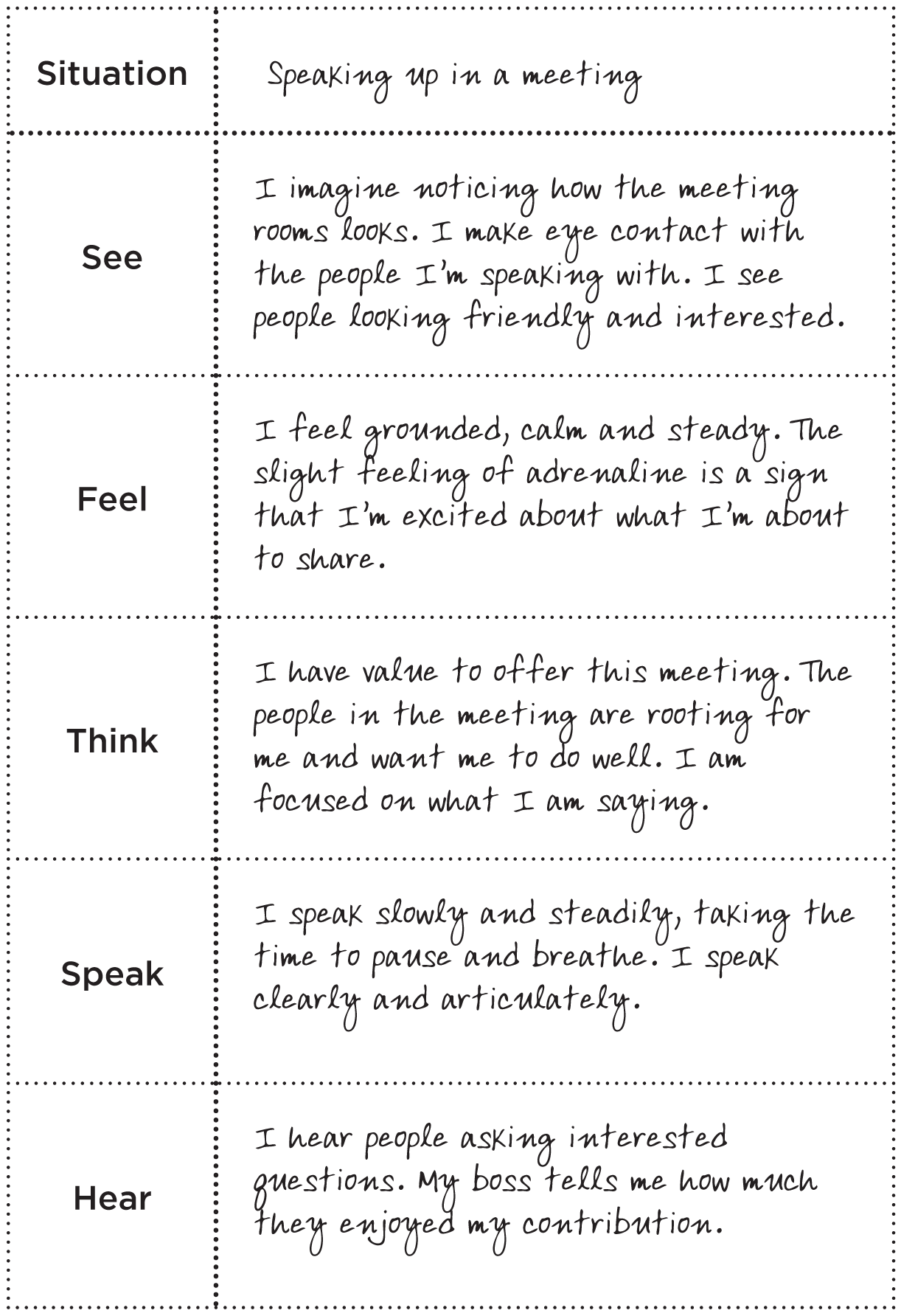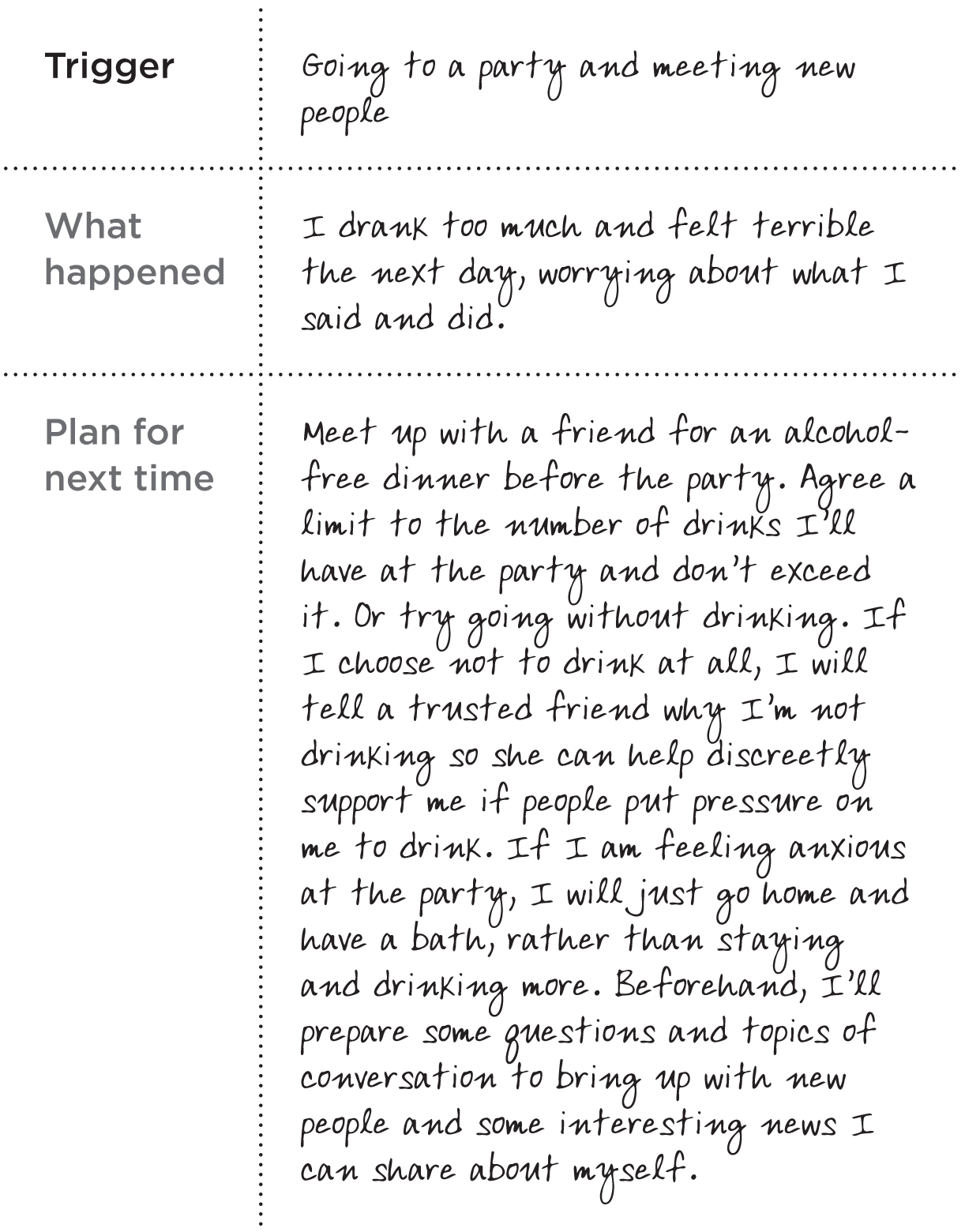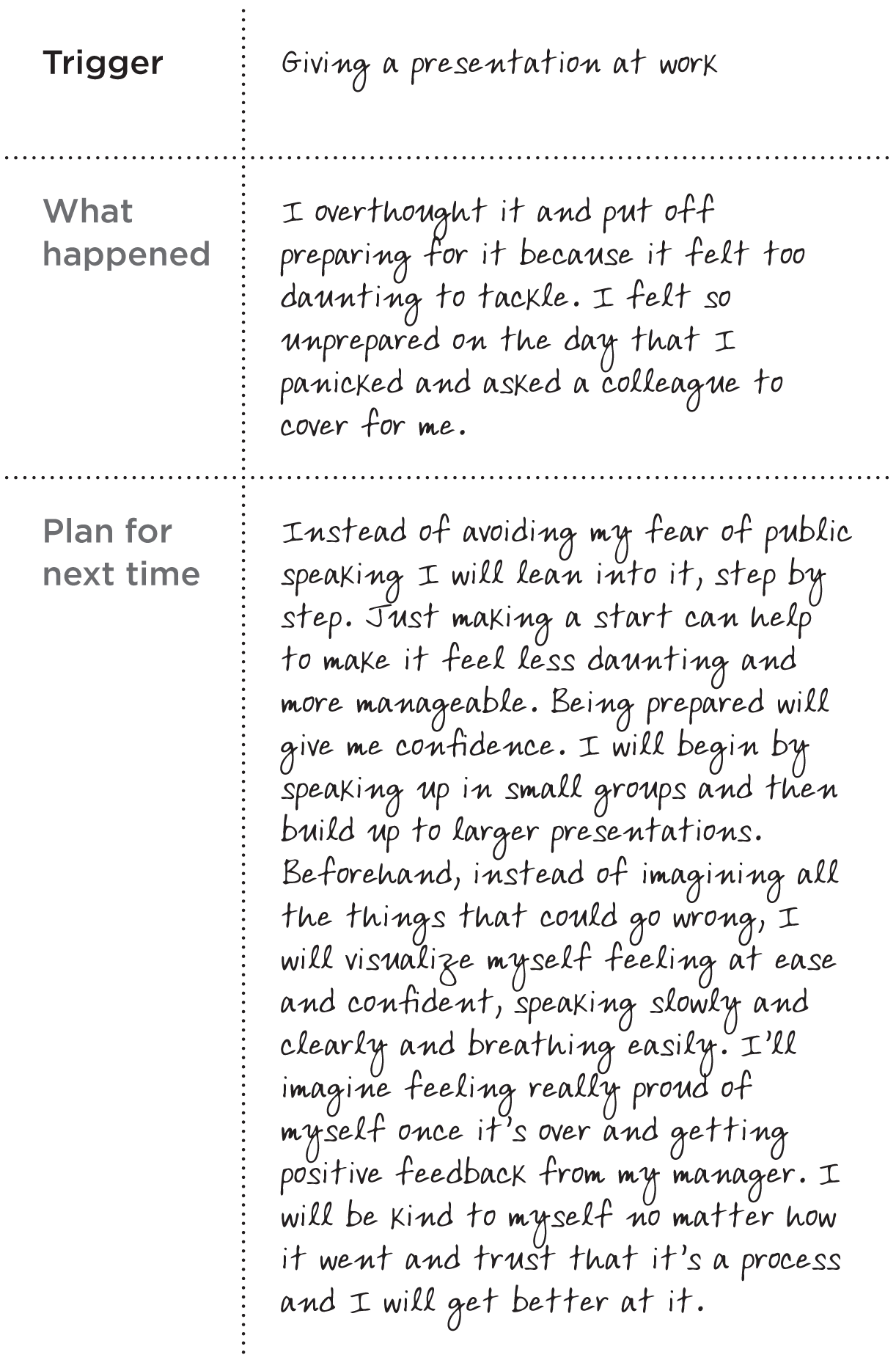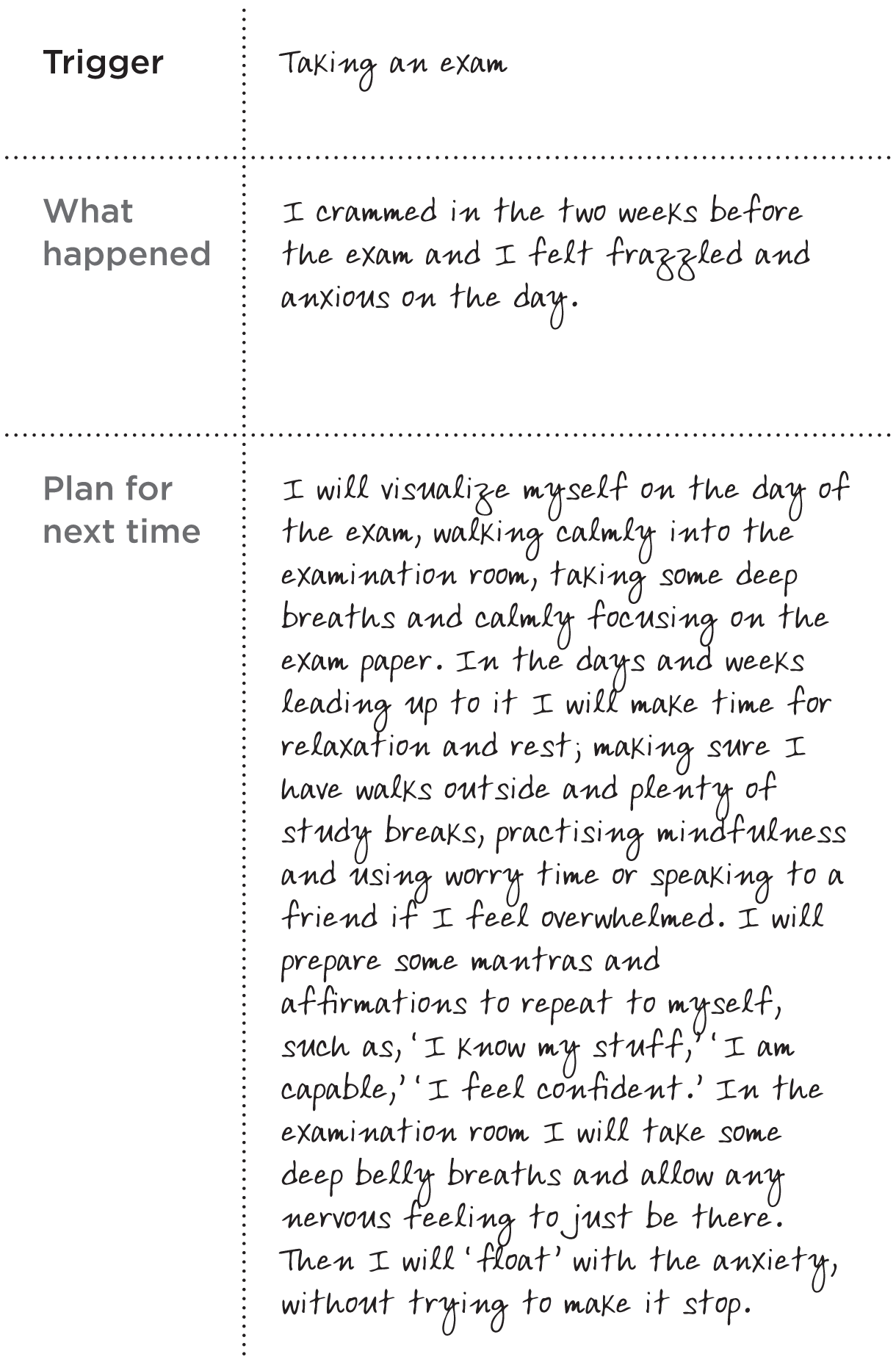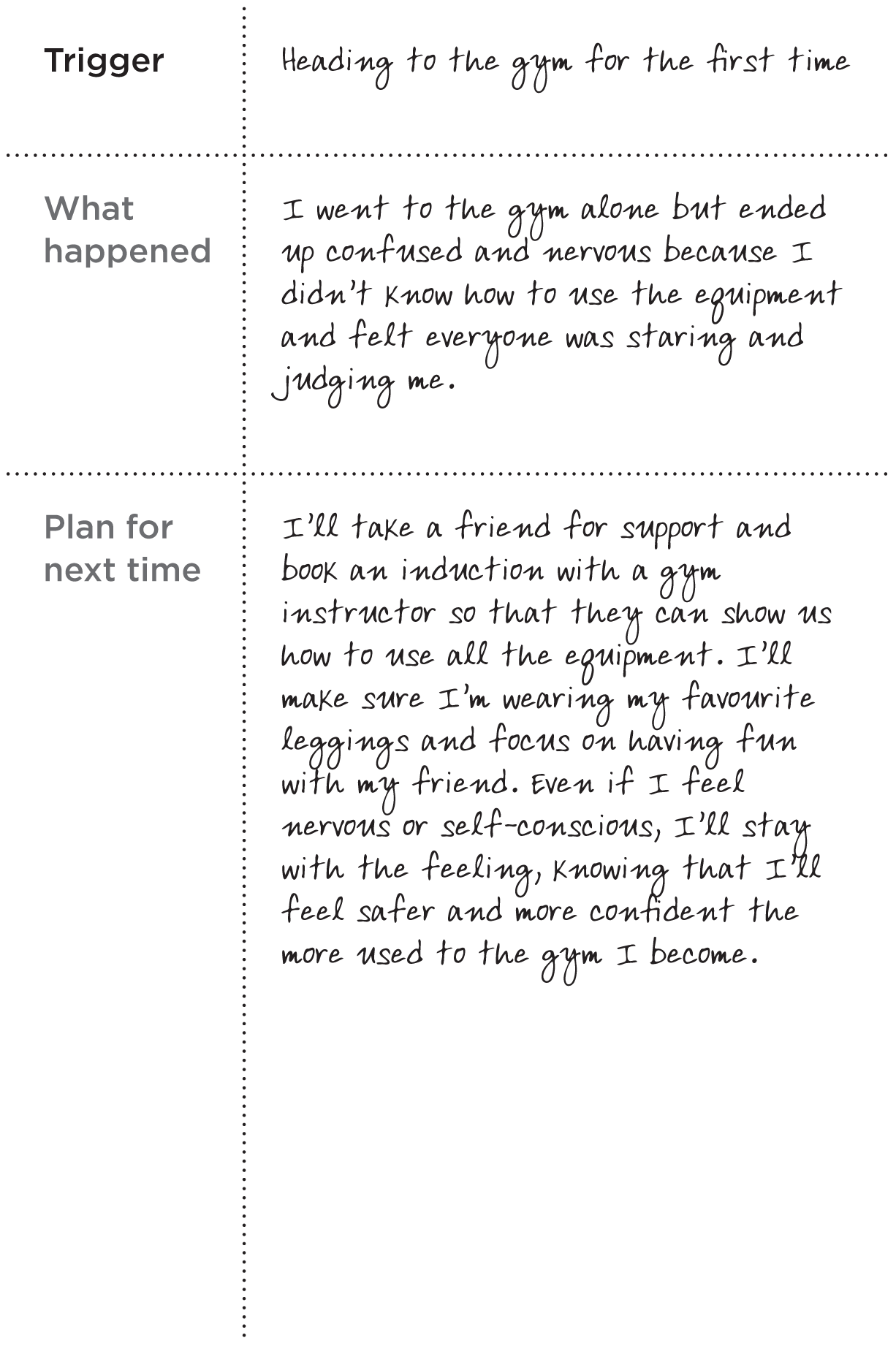
CHAPTER 9
The Anxiety Solution Toolkit
![]()
Worry never robs tomorrow of its sorrow, it only saps today of its joy.
LEO BUSCAGLIA
This chapter contains a whole host of practical ways you can minimize your anxiety. It’s impossible to stamp out all worry completely, but the following techniques have helped me and countless of my clients reduce their mountain of anxiety to an insignificant molehill. They can help you, too, if you incorporate them into each day.
At the end of the chapter is a section called Trigger tables. A trigger is anything that causes you to feel anxious. I’ve given some examples of common triggers, along with suggestions for how to manage them. It can be really helpful to track your own triggers and make a plan for how to handle them. And the final section of the chapter is a question-and-answer session (Q&A) based on the scenarios I see most frequently with my clients.
Not all the exercises I suggest will chime equally with you. That’s fine. We’re all different. But I would urge you to try all of them once; you never know how you’re going to get on with a technique until you try it. I can’t tell you how many times a client has said to me something along the lines of ‘I don’t do affirmations, they just seem so silly,’ only to come back a month later reporting that they wouldn’t miss saying their daily affirmations in front of the bathroom mirror for the world. Keep an open mind and remember, some of these techniques take a bit of practise. As always, you don’t have to be perfect at any of them, and certainly not straight away.
Let’s start with perhaps the most transformative of them all (though it’s not always easy to do …).
Schedule your ‘worry time’
One of the worst things about worrying is that it invades your everyday life. It sours moments that should be happy; it keeps you awake when you could be having much-needed brain-repairing beauty sleep; and it takes up mental and emotional bandwidth that I know you’d much rather be spending elsewhere.
So, let me introduce you to the concept of ‘worry time’. That’s right, folks, a designated time slot into which you pour all your worries and keep them tightly contained there. It’s what psychotherapist and author of The Worry Cure: Stop Worrying and Start Living, Dr Robert Leahy, suggests you do for twenty minutes each day. If you find yourself worrying at any other time, you write the worry down and postpone thinking about it until your allocated worry slot. This helps to eliminate one of the worst types of worry, which is meta-worry (that is, worrying about worrying). Having a system in place means meta-worry becomes a thing of the past. It might not be easy to postpone fretting at first, but worry is just a habit, and the more you get into the new habit, the easier it will be.
Exercise: scheduling worry time
Choose a time when you know you’ll be alone for a while. Worry time works better if you can do it at the same moment each day, as that helps form a habit – perhaps just after dinner, or on your way home from work if you don’t drive.
Get a pad of paper and a pen and write down all the things you’re worried about. You could do this on your phone but pen and paper feels more solid and cathartic. Now, notice which of these are things you have some control over and which are outside your influence. If there are things you do have some control over, find a way to take action right now. Worry, after all, can be a way of avoiding having to deal with things. So, for each worry, ask yourself, ‘What action can I take right now?’ If there is no obvious immediate action, can you at least make a plan? Jot down the first three steps of your plan and schedule them. Once you take action or start making plans, you’ll feel more effective, more focused.
This technique really helped me a few years ago, when I was worried about money. I had just become self-employed and business was slow. I found myself getting caught up with worries about not having enough cash. A lot of my time was taken up with worries that just seemed to go in circles. I realized I had to take action, so I made a list of income-producing ideas. Then I drew up a budget, mapping out what my outgoings would be over the next few months. Doing this gave me back a sense of control, helped me to feel constructive and put my mind at ease.
As you get into the habit of writing down your worries you’ll start to notice patterns in the types of things that create anxiety for you. You’ll probably notice that you have a lot of the same circular worries again and again. This will show you where to concentrate your ‘worry time’ efforts.
But what about the things that are out of our control? I hear you ask. The worries for which it would be impossible to take action or make a plan, such as worrying obsessively about other people’s welfare? These still need to be written down. Worries can seem nightmarish if left to circle your brain unfettered. Writing down those out-of-your-control thoughts will help you get them into perspective.
Exercise: writing down all worries, unedited
Stream-of-consciousness writing is an effective way to help you empty your head of worries and to uncover the real fears often hidden below the surface anxiety.
- Grab your paper or notebook and begin to write about something that’s troubling you. Keep going for at least five minutes. Don’t stop; let your hand scribble down anything your brain throws up. Sometimes writing it down can be enough to calm you.
- If that doesn’t help things to shift, try ‘answering back’ to the worry. Imagine what your best friend, your mum, a judge, or even a celeb you look up to, such as Beyoncé would say about your worry. How might they see things differently from you? What kind or encouraging words would they offer? How would they put things into perspective for you? Practise ‘answering back’ to your worries.
- As an example, say I’m worried about my boyfriend injuring himself on his snowboarding holiday. This is clearly something outside my control and aside, from telling him to be careful, there’s not much in the way of action I can take. So I might write down what my best friend would say about this. In a very patient and loving way she would point out that the chances of him having a serious injury are very small, that he’s a careful person and that everything will be OK. She would remind me that I am just ‘thinking the worst’ and that the probability of him injuring himself was very small. Beyoncé would likely tell me to focus on my own career and stop fretting over a guy, and a judge would say that, though it’s pointless to worry about something so unlikely to happen, even if it did, I should remember that I am an infinitely resourceful and capable person. I can handle it.
- It takes practice, but each time you reframe things in this way you are creating new neural pathways in your brain that make it easier to think positively in the future.
Do a social media cleanse
As we’ve seen in previous chapters, social media and limitless Internet use can be a factor in our increasing anxiety. Obsessive Instagram and Facebook habits lead to ‘comparisonitis’ and feed low self-esteem. Too much time online can also make us feel overwhelmed by being available 24/7. It’s not all bad, of course, but if it affects you negatively, consider doing the following …
- Enforce a ‘no-email zone’ between 9 p.m. and 9 a.m. – or choose hours to suit your life. You’ll be more able to switch off your brain at night and will have a more chilled-out morning. Now that I check my phone later in the day, my head is clearer and I can enjoy my morning, free of distractions and potential stress.
- Figure out what your triggers are. Do certain news sites whip you into a worried frenzy about the state of the world? Does that yoga woman on Instagram give you unbearable FOMO? Consider just not visiting the sites or apps that drive you crazy, or at least curate what you look at. It is possible to block sites on your Internet browser or un-follow certain people, you know! If someone posts stuff that drags you down, be kind to yourself and un-follow them, at least until you’re in a better mental place. Treat yourself like an experiment: if ditching news sites and social media for a week makes you feel lighter and freer, you could be on to something.
- Have an SOS: Switch-off Sunday. This means unplugging for the whole day. Leave your phone off, unhook the Wi-Fi and enjoy a day of blissful, undisturbed peace. Go outside if you can, and fully connect to the real world around you, not the online, digitally enhanced version.
Try meditation – your daily chill pill
Think of meditation as the ultimate ‘me time’. No distractions, nothing else to do but focus on doing something really amazing for yourself. We all need that. And if you’re anxious, I’d say meditation is essential. Taking time for yourself is not selfish; in fact, it’s the best thing you can do for everyone in your life. We all need time to recharge and it will make you a better friend, partner, mother, girlfriend, sister, daughter, employee or business owner and general human being as a result!
If you’ve got some resistance towards meditation, notice what thoughts pop up about it. Are you telling yourself there’s no time, or that you can’t switch off enough to meditate, or that it’s too airy-fairy? Question these thoughts and ask yourself, ‘Is this really true?’ Sometimes we resist things because, deep down, we know that they might help, and change can be scary. Consider that if you’re really resistant to something, it might be because it’s something that will truly help you.
If you’re convinced you have no time to meditate, for example, I would challenge you to think about how you are prioritizing your time. I’ll always remember watching an interview with Beyoncé where she talked about how she once put oven chips into a deep-fat fryer and practically caused a house fire. She’d never learnt to cook. That’s probably because she’d been prioritizing other things such as practising until she was an amazing singer, and building her empire!
We all have the same twenty-four hours in a day and we can choose how we spend at least some of that time. Sometimes it can feel as if there are a million demands on you and your time is not your own, but you have more choices than you think. And fundamentally, if you’re waiting for more time to materialize to do your meditation or take care of yourself, you’re going to be waiting for ever! You’ve got to make the time. It’s all about priorities.
I’ve been known to spend five minutes that turned into an hour getting drawn into some celebrity gossip site that only makes me feel crap anyway. Eventually, I realized it was because I wanted to do something mindless that would help me to switch my brain off. These days, I try to use my chill-out time more wisely, by meditating and being mindful.
Look at what you’re doing to unwind and ask yourself, ‘Is it really working, and is there a better way to spend that time?’ Whether you’ve been playing Candy Crush, reading junk online or aimlessly cruising social media, could you use that time to really relax and do something positive for yourself? The truth is, we all have ten minutes a day to meditate; we just need to choose to do it rather than doing something else.
Meditating first thing in the morning works for lots of people. Katy Perry props herself up in bed as soon as she wakes and does twenty minutes of transcendental meditation, a type of meditation where you say a mantra silently to yourself. ‘It puts me in the best mood. It’s the only time my brain gets complete rest.’1 As Katy says, ‘I don’t have a whole lot of time. Meditation extends my day so I can live at my fullest capacity.’ Think of it as an investment of your time that pays back in happiness, calmness, focus and productivity many times over.
So when is a good moment to meditate?
- If you commute to work by train or bus, make the most of that time by closing your eyes and listening to a guided meditation or mindfulness meditation.
- Or why not sit in the park at lunchtime and take ten minutes for yourself?
- You could also meditate as soon as you get home from work, to wash away the day’s stress.
- Another time is right before bed, although you might be too tired by then, so it doesn’t work for everyone. Try it. If you keep falling asleep, another time in the day might be better.
If you’re telling yourself you won’t be any good at meditation, try to take a step back from your perfectionist worry. It’s all too easy to put a ton of pressure on yourself to be brilliant at everything and, if you generally need things to be perfect then you’ll probably be the same with meditation. You’ll convince yourself that, unless you can clear your mind of all the internal chatter or sit cross-legged like a Zen monk for hours, then it’s just not worth bothering. ‘I knew there was something there for me, in meditation, but every time I would try to do it, I was like, “I just cannot meditate!” ’ Cameron Diaz once said in an interview.2 She stuck with it, though, and now she is a spokesperson for the benefits of meditation. What helped me the most was being very gentle with myself, resisting my need for the meditation to be a certain way and instead just going through the process.
Different types of meditation
There are lots of types of meditation, and different styles will work for different people. If you’ve tried one type before and didn’t get on with it, don’t give up! We can all meditate; it’s just about finding something that suits us.
Mindfulness meditation
This involves paying very close attention to your breath. It trains your mind to be in the present moment, which is so helpful for relieving anxiety. One study found that mindfulness meditation helped to reduce activity in the amygdala – the part of the brain responsible for feeling fear3 while in another, mindfulness helped 90 per cent of people reduce their anxiety levels.4 When you’re mindful, present and aware, you’re much less likely to spin off into negative thinking or worries, and that can only be a good thing.
Something I find fascinating is how meditation actually changes the structure of your brain – in a good way! Neuroscientist Sara Lazar at Massachusetts General Hospital and Harvard Medical School carried out research with long-term meditators. Participants doing mindfulness meditation showed a reduction in the sizes of their amygdalas and Sara concluded that they consequently had less of a tendency to overreact to perceived threats. They felt less stressed and anxious and became more self-aware and able to better navigate potentially stressful events.5
I hope you’re convinced of the benefits and raring to go! Start with the following simple meditation exercise. You can also try the Anxiety Solution mindfulness meditation download in the online book bonuses, or one of many commercial apps available. If you fancy going to a class or getting some guidance in person, you could also check out your local Buddhist centre. When I went to mine, there were all sorts of people there and it didn’t feel in any way religious; there were builders, bankers, students, mums, old folks, young hipsters, media luvvies and every type of person in between.
Exercise: mindfulness meditation
- Set a timer for fifteen minutes. If possible, find a timer app with a gentle gong sound that you can programme to go off at five-minute intervals. Sit comfortably (it doesn’t have to be on the floor, or cross-legged), with your hands facing upwards on your lap, eyes closed.
- Inhale and exhale normally, focusing on the sensation of the air passing into and out of your nostrils.
- For the first five minutes, silently count up to ten after the exhales. In other words, after each complete inhale and exhale, count ‘one’ in your head, then after the next one, count ‘two’. Do this all the way up to ten, though don’t be surprised if you don’t get anywhere close to ten before your mind has wandered off down some thought trail.
- As soon as you notice your mind has wandered, gently bring it back to the breath, starting at one again.
- After five minutes, change the count so it’s before the inhales. Although, technically, it’s the same thing, changing where you place the count emphasizes the inhale more than the exhale, making it subtly different.
- Continue for another five minutes, this time losing the count and focusing purely on the sensation of the breath going into and out of your nostrils, throat and lungs. Immerse yourself in this sensation until the timer goes off.
Transcendental meditation
This type of meditation, often abbreviated to TM, involves silently repeating a mantra (a sound or word) to yourself as you sit with your eyes closed. The mantra is given to you by a practitioner and is unique to you. Transcendental meditation helps to quieten the mind and lower stress. Evidence shows that it reduces anxiety more effectively than pure relaxation techniques6 and reduces levels of stress hormones.7 It’s also thought that TM helps to strengthen communication between the brain’s prefrontal cortex and other areas, which means that emotional responses to life are more balanced.8 TM needs to be learnt from a qualified teacher so, to find out more, visit uk.tm.org.
Guided meditation
This involves the participant listening to instructions on how to think in a focused way about certain things, such as a nature scene; or parts of the body, in order to relax them. Guided meditation, which some say is more visualization than pure meditation, has been found to induce the ‘relaxation response’ by lowering heart rate and reducing blood pressure.9
Guided meditation practice has also been found to significantly reduce perceived stress levels. Get a free guided meditation in the online book bonuses section at www.calmer-you.com/bonus.
Exercise: guided visualization meditation
Sit comfortably in a chair, or lie down in bed, and close your eyes. Take some deep breaths through your nose. With each out breath, feel yourself settling further into your seat or on to the bed. Then either say the following words slowly to yourself in your own mind, or record them on your phone to play back to yourself. Remember to pause between each sentence to give yourself time to engage your imagination. If you’re not a visual person, tune into the sounds or feelings instead.
Imagine you are walking along a beautiful, peaceful beach. Imagine smelling the sea air and feeling the sand underfoot. As you take each step, you feel more and more comfortable. Feel the warm sun on your skin and hear the sound of waves rolling into the shore. Look around and notice the blue sky and the sunshine sparkling on the surface of the ocean. As you walk along the shore, the cool, refreshing water laps over your feet, washing away stress as each wave recedes. You continue to walk along the beach, noticing everything you see, hear, smell and feel and allowing every step to relax you more and more.
Moving meditation
If a seated meditation seems impossible to you right now, try one that involves movement. Practising yoga, doing t’ai chi or even walking can all be forms of meditation when you pay very close attention to what you’re doing. The next time you go for a walk, read the following meditation a couple of times first and then use it to guide and focus your thoughts when you’re out.
Exercise: a simple walking meditation
Notice the feeling of the ground under your feet, the air on your skin and the sights, sounds and smells around you. Pay close attention to every step and the feeling of your body as it moves. Notice all the subtle sensations of your feet touching and then leaving the ground as you walk. As soon as you notice your attention wandering off, as it always will, bring it back to the experience of walking. A wandering mind is totally natural, so don’t worry about it, just keep bringing your attention back to the feeling of walking. It’s a great way to calm you mentally and help you to be more present.
Be mindful in the moment
Mindfulness has been in the media a lot over the past five years or so and it kind of goes hand in hand with meditation. If you meditate, you’re naturally going to be more mindful, but you don’t necessarily need to meditate every day to make mindfulness a part of your life.
The essence of mindfulness is to pay attention to the present moment rather than worrying about stuff from the past or in the future. It’s also about being open to your current thoughts and feelings rather than judging yourself for having them or trying to control or suppress them. Mindfulness helps you to be the objective observer of your thoughts rather than getting tangled up with and pulled down by them. Being the observer means recognizing you are not your thoughts but rather the awareness of your thoughts. I view mindfulness as a workout for my brain. Your attention is like a muscle, and the more you flex it, the stronger it gets and the calmer and happier you become as a result.
This awareness of our thoughts is vital because our thoughts both reflect and determine our moods. Although it’s almost impossible to measure, it’s often estimated that we have between 12,000 and 70,000 thoughts every day. A sad fact is that the vast majority of this mental chatter is negative. Psychologists call it ‘negativity dominance’. In a study by Dr Raj Raghunathan at the University of Texas, students were asked to record their automatic thoughts throughout the day. It was found that 60–70 per cent of these thoughts were negative. The problem is, negative thinking becomes a habit. It’s believed that 98 per cent of our thoughts are in the same mood as the ones we had yesterday.10 Left unchecked, those negative thoughts can quickly turn into a habitual bad or anxious mood that feels as if it’s an inevitable part of our life and personality. So it’s vital to disrupt the obsessive negative thinking. When you’re more mindful, if a negative thought does pop in, such as ‘I’ll never be good enough to get promoted’ or ‘I’m a terrible mum,’ you will be able to see it for what it is – just a passing thought – rather than taking it too seriously. It’s a bit like standing on the ground looking up at clouds. When you’re not being mindful, you can get sucked up into a tornado if you’re not careful! Being mindful means you can observe the clouds as they float overhead and then out of sight.
Mindfulness is fantastic for tackling habitual negativity and it’s also a powerful weapon against the mindless churn of worry that can make you feel as if you’re living on autopilot. A few months ago I was walking along a street and had something on my mind. It wasn’t until I reached my destination that I realized I’d been on total autopilot the whole way there and had no recollection of seeing anything between points A and B. I had been mulling over some possible outcomes for a work situation and replaying stressful conversations I’d had in the past. I hadn’t even noticed I was worrying. Worry had hijacked the controls and I was just along for the unhappy ride. I used to do this all the time.
When our minds are on autopilot, we’re not really in control of the thoughts that pop up. Any old rubbish can come in because, unfortunately, thanks to negativity dominance, our minds often gravitate towards negative thoughts and worries. Mindfulness increases your awareness of your whole environment, including the thoughts you’re thinking. It puts you back in control of what you think about and sets you on course to a better mood and less anxiety.
Mindfulness is also an immunization against overthinking. When we’re more mindful and present, we’re not getting lost down the rubbish chute of worry. It’s impossible to be mindful of the present moment and to worry about the future at the same time. Your brain literally can’t do those two things at once. So, as often as I can, when I’m walking to work, I tune into the colour of the sky and the patterns of the clouds. I notice the feeling of the ground underfoot, the breeze on my skin, and the smells and sounds around me. It’s like being ‘at the controls’ of my mind rather than on autopilot. If a negative thought comes in, it’s easier for me to catch it before it spirals. I’m able to recognize that the thought is just a thought, not a fact. I become the observer of my mind rather than believing I am the thoughts themselves.
Mindfulness meditation, where you ‘watch your breath’, is a great way to flex your mindfulness muscles, but it’s not the only one. Here are some simple things you can do to add more mindfulness to your life without having to sit on a cushion for twenty minutes.
In the shower
As you lather up your body and shampoo your hair, pay attention to the feel of the water, the smell of the soap and the sensation of massaging your scalp. I used to worry and stress about the day ahead while I was showering, but these days I use it as time to be present and tune into the moment.
As you eat
Step away from emails at lunchtime and instead focus entirely on what you are eating. Most of us rush through our food and barely even taste it. Why not use meal times as a chance to practise being mindful? Notice the colours and smells of your food, eat slowly and pay attention to each bite.
While you clean
Yes, folks, who knew that doing the washing-up could be an antidote to anxiety? When you’re totally focused on scrubbing those plates, feeling the suds and the warmth of the water and smelling the washing-up liquid, you can’t be worrying at the same time. Plus, there’s something strangely satisfying about being really present as you do housework. I’m serious! Try it.
During a workout
It’s easy to want to mentally ‘check out’ when you exercise (I know I’m not the only one who wants to avoid feeling the burn!), but being mindful as you run, swim or do yoga can deliver rewards that go way beyond the physical. Use this time to tune into your body and your surroundings and to tone your mindfulness muscle as well as your glutes. This is even more powerful when you exercise outside rather than staring at the wall in front of you while you pound the treadmill. It’s just more inspiring to lose yourself in nature and the natural environment.
A quick zapper for negative thoughts
This very simple tool is extremely effective. Every time you catch yourself getting caught up in negative internal chatter, address the negative thought directly. Hear it out and then say, ‘Thanks for sharing.’ Acknowledging the thought is easier than trying not to hear it in the first place. When you thank it for its contribution, you recognize the part of you that is anxiously trying to keep you safe, even if it’s completely misguided and its approach isn’t very friendly! When you say, ‘Thanks for sharing,’ you can kiss your negative thoughts goodbye.
Part of the reason this technique is so powerful is that it builds on the fact that you are not your thoughts, which is a fundamental insight derived from mindfulness. Once you learn to step back and observe your thoughts, you are back in the driving seat.
So if these thoughts are not ‘you’, where are they coming from? Often they bubble up automatically from your subconscious mind, the result of things you’ve been told and beliefs you have about yourself and the world. They are like mental reflexes, based on programming and experiences from the past.
When you were a child, you might have been told things such as ‘The world is a dangerous place,’ or ‘Be a good girl so your teacher will like you.’ When you’re young, your brain is like a sponge. It soaks up anything and everything, and of course you lack the life experience to evaluate the validity or usefulness of the things you hear. Naturally, you end up believing many of them. These beliefs tend to hang around and colour your thoughts, feelings and habits. They are often untrue, but that doesn’t stop your subconscious mind from replaying them again and again.
I had a client, Sara, who as a child was told by her stepfather that she wasn’t intelligent. Her subconscious mind replayed this belief over and over with thoughts such as, ‘I’m too stupid to speak in public,’ and ‘There’s no point going for the promotion, I’ll never be good enough.’ Despite the fact that she had a PhD, she worried constantly that she was a fraud. I suggested to her that she try out the negative thought zapper. It took a bit of practice but eventually Sara learnt to say to the thought, ‘Thanks for sharing,’ and then ignore it.
Be grateful for the good stuff
I’ve had client after client tell me that practising gratitude is the thing that helps them shift from a negative to a positive mindset almost instantly. It’s another one of those seriously simple but mega-powerful ideas that really works.
When we’re anxious, we’re prone to thinking the worst and focusing on the negative stuff. But what if you could rewire your brain to be more optimistic? In his book The Happiness Advantage: The Seven Principles of Positive Psychology that Fuel Success and Performance at Work, psychologist Shawn Achor describes how being grateful for the good things in our lives and mentally ‘seeking out’ more of them trains our brains to see them automatically. It’s like training a positivity muscle. People who actively look for the good and are thankful for it become more naturally optimistic and positive. There is solid evidence from numerous studies that regular gratitude practice improves mental wellbeing and makes us happier and calmer.11
Exercise: practising gratitude daily
Write down at least three specific things you’re currently feeling grateful for. It might be something small such as the delicious cup of coffee you’re drinking or having a beautiful park or garden to visit near where you live. Maybe it’s the fact that your partner gives the best back rubs, or that an amazing bookshop has just opened up near your office.
The more specific you can be, the better, because it gives you more scope to think of new things each time you do the exercise and means you do more mental searching. If you just write ‘I’m grateful for my family’ every day, it’s going to lose its meaning pretty fast, whereas if you list a different specific thing about each family member, this will work wonders!
Another powerful practice is to scan through the day just before you go to bed and make a note of all the things that went well. Perhaps you had a great catch-up with a colleague, or it was a nice day so you went for a walk, or you made a new recipe and it turned out great. Scanning the day for good things helps to make you feel more positive.
Use affirmations to boost positivity
What have you been telling yourself recently? If you’re anything like I used to be, chances are you’ve been a mental bully, locked in negative cycles of thinking, telling yourself that you’re no good or will never feel better. The way we speak to ourselves is important. As a push back against all that self-critical chatter, I suggest creating some mantras or positive affirmations for yourself. When you repeat them, whether it’s out loud, in your head or by writing them down, it starts to become a mental habit to think those positive thoughts. As we’ve already seen, thoughts can eventually become beliefs, through sheer repetition and force of habit.
Affirmations absolutely must be a positive statement, and they work best when you say them as if they are happening now. So instead of saying, ‘I will never be scared of speaking in a meeting again,’ or ‘I will feel more confident,’ tell yourself ‘I am confident.’ You can get a free affirmations audio track in the book bonuses section at www.calmer-you.com/bonus.
Exercise: affirming positivity
Here are some examples you could use, or make up your own. Write them down and repeat them to yourself every day. You could stick them on Post-its around your home or make a note of them on your phone so you can refer to them easily. Say them like you mean them (even if you don’t at first – that will come).
- I am confident
- I am relaxed and at ease
- I feel good about myself
- I am clear-headed and free
- I am enough
- My best is always good enough
- I am a kind person
- I am brave
Practise self-compassion and self-love
Every single time you do something positive for yourself, such as cooking a healthy meal or sitting down to do a guided meditation, you are practising self-love. The basis of everything in this book is the idea that when you practise self-love it’s an act of deep compassion towards yourself. And that’s especially important for those of us who are prone to anxiety because so often we beat ourselves up, feeling guilty and being self-critical.
Self-compassion means forgiving yourself for petty errors and misdemeanours, the kind of things you would always overlook in a friend. Self-love, as we’ve already seen, is not about boosting your ego so much as caring for yourself as you would for a friend or family member who needed your help. In a way, this whole book is about self-love, but I want to share a couple of specific techniques to demonstrate to your deep self that you value yourself. They are guaranteed to put you in a better mood.
Exercise: write yourself a letter of support
This first one comes from self-compassion researcher Dr Kristin Neff. The letter must be from the perspective of a friend who is unconditionally loving and accepting of you (it could be an imaginary friend). This friend knows you inside out, all your amazing qualities and all of your flaws, and accepts you totally. They recognize that, as a human being, you aren’t perfect, nor should you be. You might want to write about their view of one of your current worries or something more general about you and the history of your friendship, but whatever you write about, fill the letter with understanding, support and love.
Exercise: seeing through the eyes of someone who loves you
Get comfortable and close your eyes. Imagine a person who really loves you is standing in front of you. Float up out of yourself and into their shoes. See yourself through their eyes. Feel with their heart. Hear with their ears. See all the incredible things that they see in you; your smile, your amazing sense of humour, your unique style, your beautiful mind and the quirks that make you the gorgeous, lovable woman that you are. From their perspective, tell yourself everything you need to know to understand how loved and valued you are. Send a warm glow back to yourself, then float back into yourself and receive it.
Teach yourself to relax
If you’ve ever thought to yourself ‘I can’t relax,’ or ‘I can’t switch off,’ you’re not alone. I hear it all the time. We get so used to being on high alert that we actually forget that being calm and at ease is our natural state. But relaxation is something that you can practise and get better at. Here are three simple ways to relax, wherever you are.
Exercise: the ‘3–5’ breathing technique
Put your hands on your belly and relax your stomach muscles. Take a deep breath in for a count of three and then breathe out for a count of five. As you breathe in, let your belly expand like a balloon, and as you breathe out, let the balloon, deflate. It doesn’t matter how quickly or slowly you count; what’s important is that the out breath is longer than the in breath and that you’re breathing into your belly. What this breathing exercise does is send a message to your nervous system that it’s safe to relax. Lengthening the out breath and breathing into our bellies gets us out of fight-or-flight mode and in to rest-and-digest (i.e. relaxation) mode. As an added bonus, focusing on counting helps to distract and calm your mind. Do it for a few minutes or for as long as you need to.
Exercise: the body-scan muscle relaxation
The aim of this exercise is to mentally scan each part of your body, from your toes up to the top of your head, and consciously relax each muscle group. Begin by directing your attention to your toes and mentally say to yourself, ‘Toes, relax.’ Then move through your ankles, calves, knees, thighs, hips, stomach, buttocks, chest, back, shoulders, arms, hands, neck, scalp, forehead, eyes, mouth and jaw muscles. With each area, think, ‘Relax,’ or simply imagine the area relaxing. It’s a great exercise for releasing tension from your body, calming your mind and bringing you in to the present moment.
Exercise: tune into your body
It’s basically impossible to be focused on your body while simultaneously worrying about something. You can’t focus on the two at once, so tuning into how your body feels is a quick way to get out of your head. Whether you’re sitting on the train, on the sofa or walking down the street, focus all your attention on how your body feels. Pay attention to the energy in your body, notice its temperature, notice the sensations or the feeling of your pulse. Try to allow the whole of your attention to be taken up by an awareness of what it feels like to be in your body. Hold it there for as long as you like. When your mind drifts, gently bring it back.
Visualize your anxiety-free life
When you vividly imagine something, your unconscious mind doesn’t know the difference between that and the real situation. Anyone who feels anxious just thinking about a fear-triggering situation will know this is true! Many people with anxiety use the power of their imagination to visualize the worst-case scenario, which only creates more angst. Instead, you can use your imagination as a force for good. When you mentally rehearse a situation that typically makes you anxious, imagining things turning out fine and handling any hiccups along the way all while remaining relaxed, you create new neural pathways in your brain that correspond with feeling relaxed when the real-life situation comes about. Sportspeople such as Usain Bolt and Michael Phelps are known to mentally rehearse their events. They see them going well in their minds and it helps them to be calm and confident in their competitions.
Exercise: visualizing positivity
Close your eyes and get comfortable, lying in bed or sitting in a chair. Take some deep breaths and imagine your body settling further into the bed or chair with each out breath. Carry out the ‘body-scan muscle relaxation’, if you have time. Now begin to imagine a situation that has made you anxious in the past – examples might be giving a presentation, going to a new place, meeting new people or flying in an aeroplane. Tune into all your senses and visualize how you’ll look, feel, behave, what you’ll do and how other people will respond to you when you are next in the situation. Imagine what you’ll hear and say and the thoughts you’ll have. Visualize yourself feeling confident, relaxed and comfortable. See that, if any problems arise, you can handle them calmly. Imagine feeling great afterwards, knowing that you did your best.
Every time you do this exercise you are creating new neural pathways which will eventually make these new thoughts, feelings and behaviours automatic for you. Practise this visualization daily for a few minutes and you will train your brain to feel relaxed and confident in the situation. Don’t worry if you can’t imagine things clearly or you’re not very visual, just do it in the best way you can. Some people tune into the feelings rather than the images, and that’s just as good. Even if at first it makes you anxious just to imagine a situation, mentally rehearsing it will desensitize you to it. The process works in the same way as classical conditioning (remember Pavlov’s dog?). Your brain learns to associate the scenario with feeling relaxed instead of feeling fear. Keep practising until you feel completely calm when you think of the situation.
✎ Exercise: Copy the following table in your notebook and map out how you will use your imagination to mentally rehearse different situations. Using all your senses helps to make it more powerful.
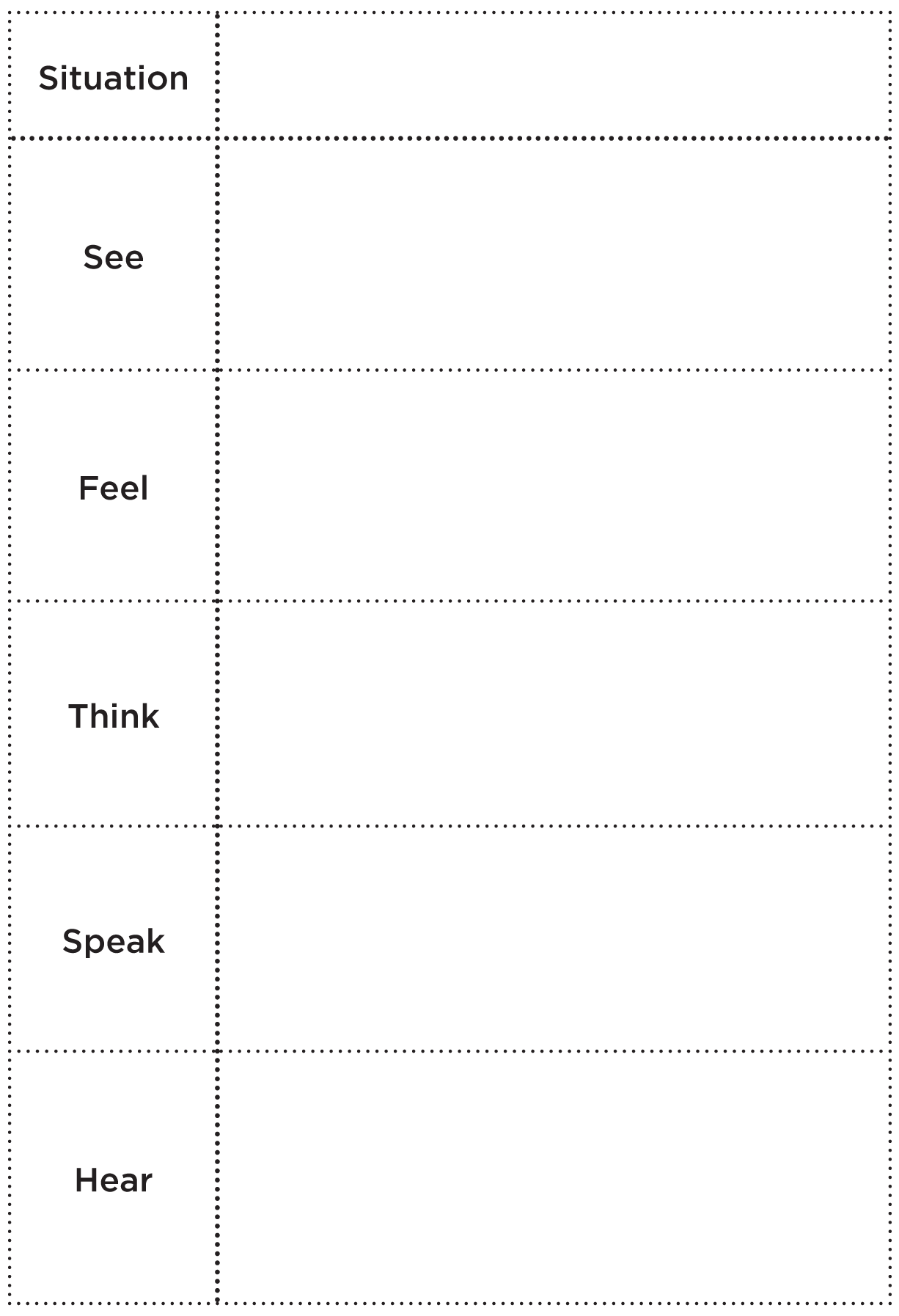
A checklist for better sleep
If anxiety prevents you from sleeping, ensure you’ve got the following ticked off to give yourself the best chance of a good night’s rest.
- Caffeine hangs around in the body for hours after we drink it; some studies suggest for as long as fourteen hours. So keep coffee and tea drinking to the early mornings only.
- Reading fiction for twenty minutes or so before bed can help you to switch off and let go of the day. It’s a great escape from your everyday life and worries.
- The bright blue lights from computers and phones stop our brains from producing melatonin, the chemical that makes us go to sleep. Stop using screens for at least an hour before bed and consider installing a program called Flux on your computer if you have to work late. It makes the light more orange-toned so that your brain still produces melatonin.
- Write yourself a to-do list for the following day so you don’t have everything swirling around in your head as you’re trying to drift off.
- Park your worries on paper before you go to bed. You can return to them in the morning, if you must!
- An obvious one, but do make sure your bedroom is dark enough or wear an eye mask. And block out any noise with headphones or earplugs.
- Try out the food supplement 5-HTP. It helps our bodies to produce serotonin and therefore makes us more relaxed and sleepy.
- Try a bit of pre-bedtime yoga, even if it’s just a few gentle stretches. Check out Youtube for some instructional videos or try the app Yin Yoga if you don’t already practise yoga.
- Do some 3–5 breathing. Breathe in for three and out for a count of five. It’s all about lengthening the out breath, which reduces stress and gets the nervous system ready for sleep.
- Don’t watch Game of Thrones (or any other ‘exciting’ programme) just before you go to bed, as it can amp you up too much to sleep. I’ve learnt this the hard way!
Trigger tables
A trigger is anything (an idea, a situation, a time of the year) that brings up anxious thoughts and feelings. It can be helpful to make a note of which situations trigger anxiety for you so that you can make a plan for how to handle that situation if it comes up again. Knowing that you’re well prepared will help make the situation much easier to manage.
You may find that some of these examples resonate with you. The most valuable thing you can do, though, is to grab your notebook and draw up your own trigger tables, making them as specific and personal as you can.
✎ Copy this table in your notebook and schedule in your self-care and relaxation time.
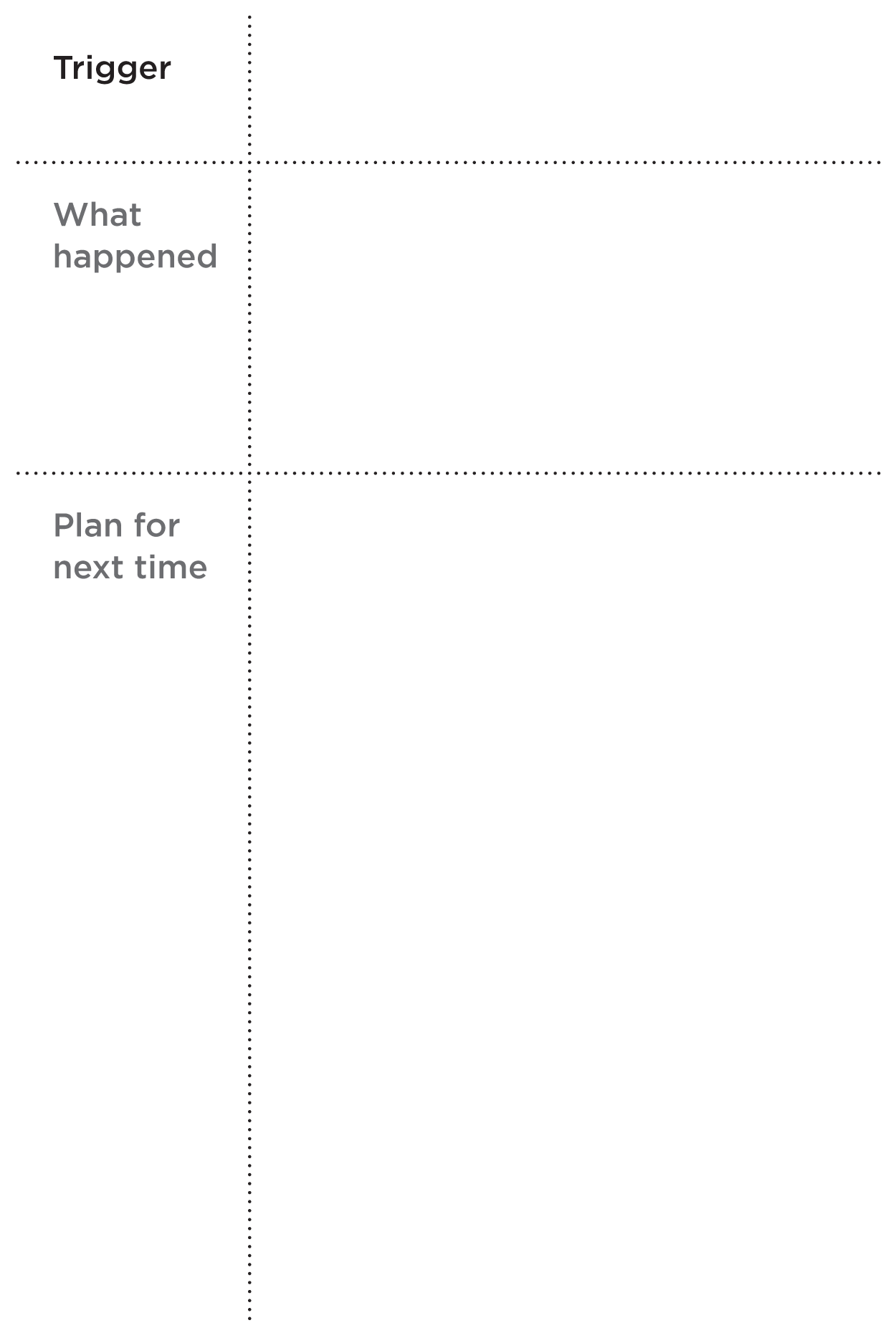
Brainstorm twenty ideas for activities that sum up self-care and relaxation for you.
✎ Examples:
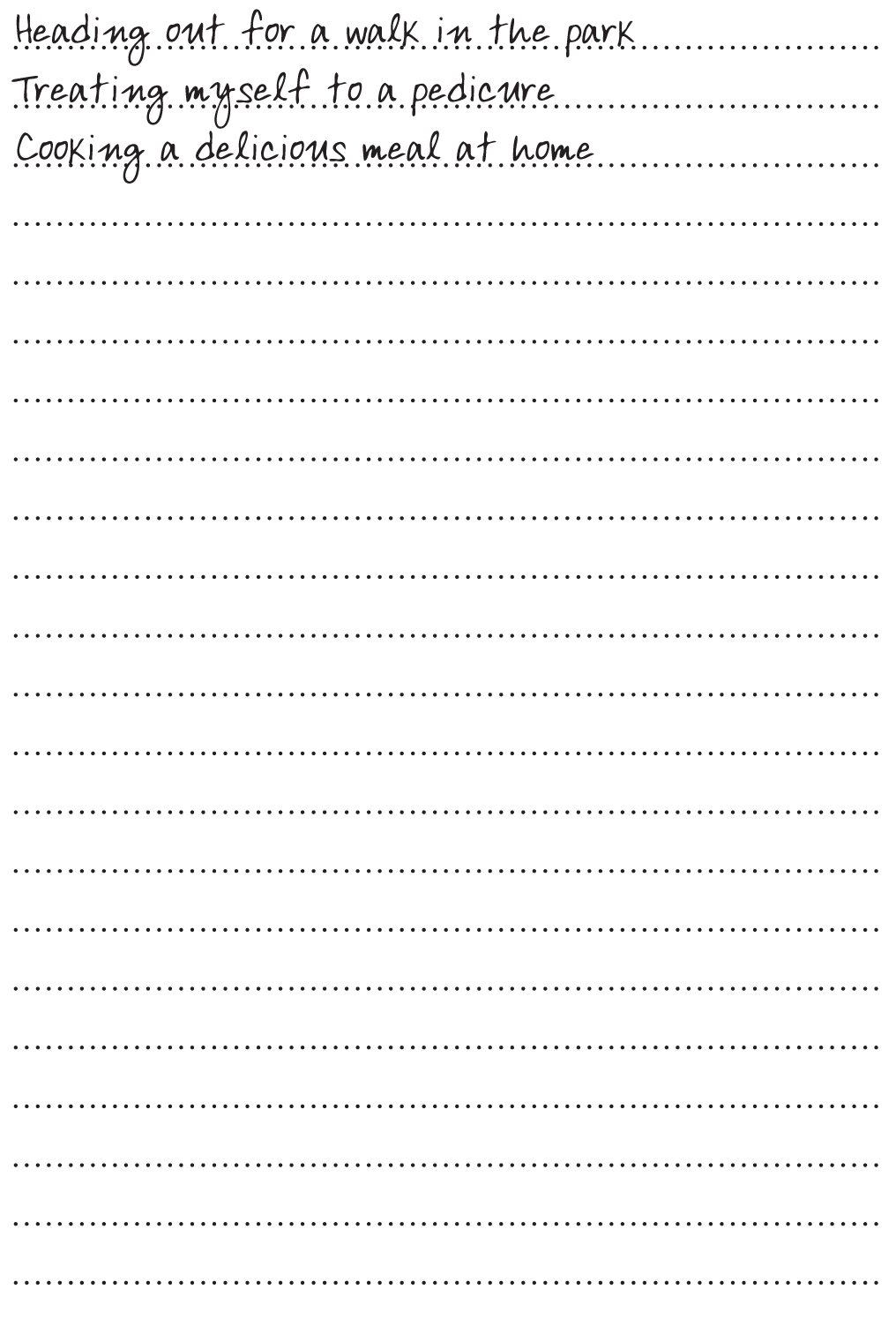
Self-care diary
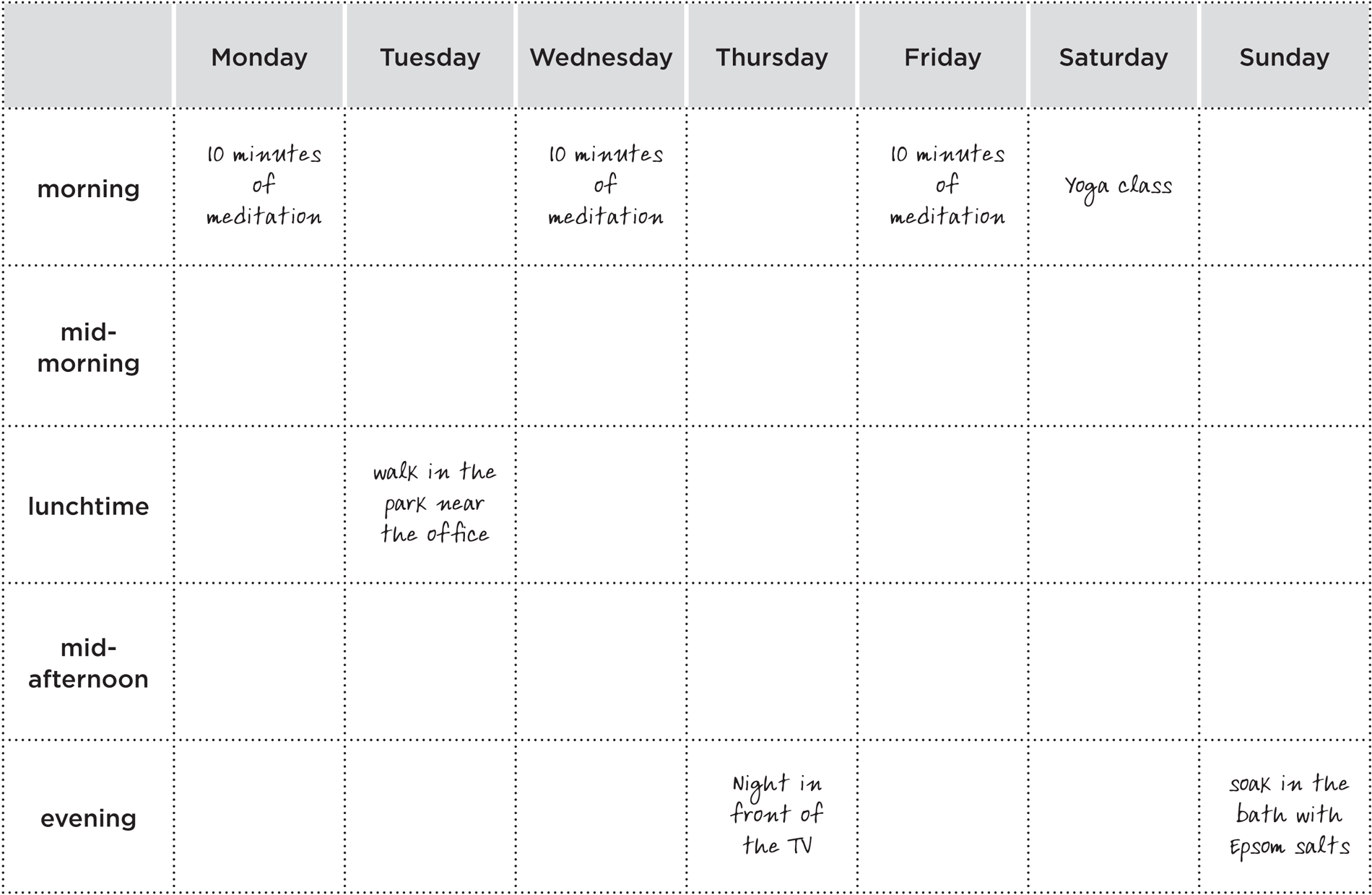
✎ Copy this table in your notebook and schedule in your self-care and relaxation time.
Try to do something each day.
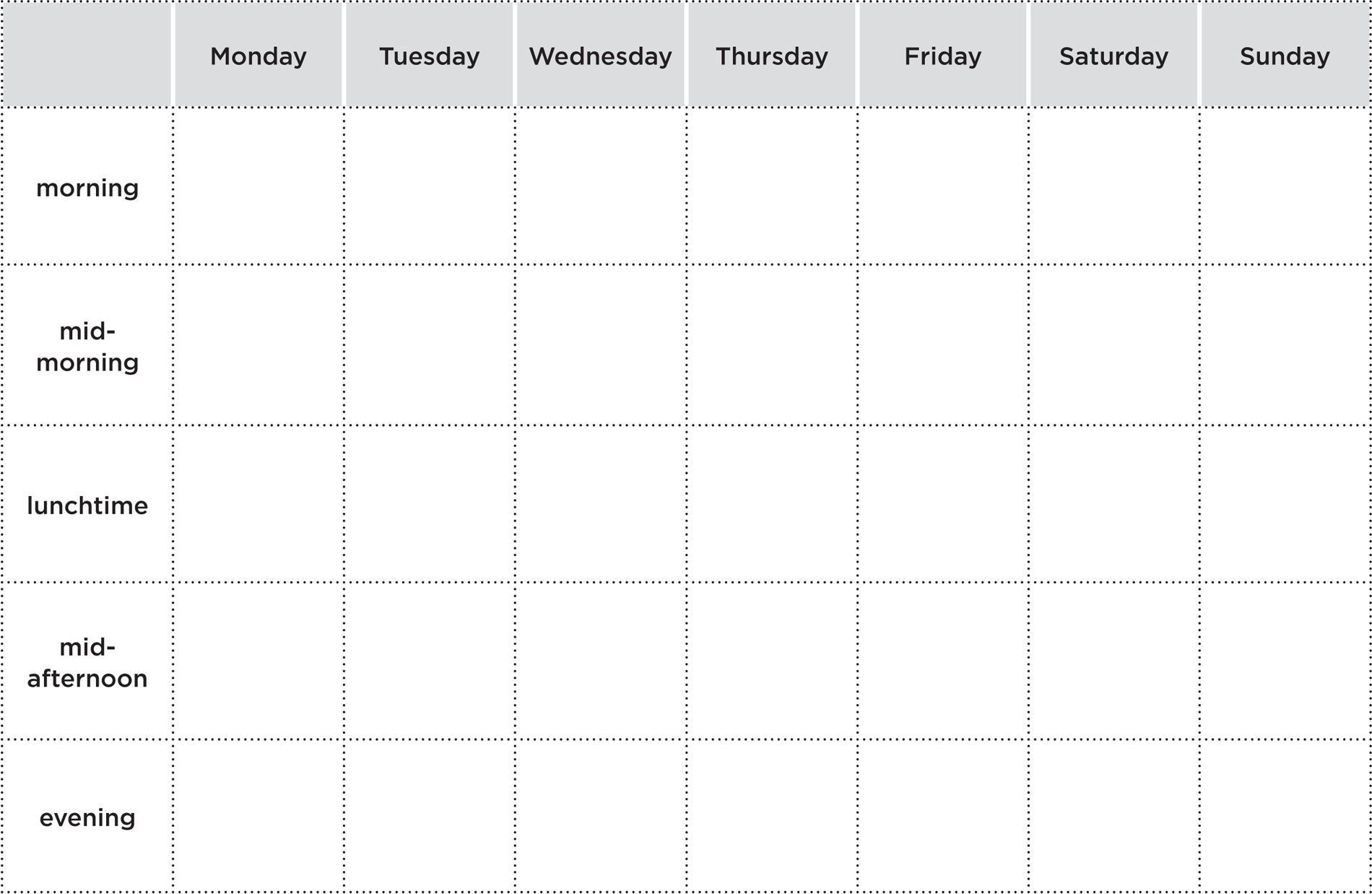
Q&A
Here are some answers to the questions I get asked most frequently by my clients and by women on social media.
It’s Sunday night, I have a really important day at work tomorrow and I can’t sleep. Aargh! What should I do?
Get out of bed and either read some fiction (a book, not on your phone!) for fifteen minutes, listen to a guided meditation or hypnosis audio (available at www.calmer-you.com/bonus), or do a body-scan muscle relaxation. Doing something calming and focused is often enough to distract you and calm you down so that you can sleep. Remind yourself that, no matter what Monday brings, you’ll handle it. Some people find it helpful to do a ‘brain dump’ of worries and ‘to-do’s’ to return to on Monday morning. Getting it down on paper can be a relief. For future, avoid coffee after lunchtime (caffeine takes ages to get out of your system) and do some exercise or yoga stretches to wear yourself out before you go to bed. I particularly like the yoga app Yin Yoga.
I just logged in to Instagram for five minutes … that turned into an hour of checking out my favourite beauty bloggers. Now I can’t stop comparing myself to these gorgeous women and I’m an anxious wreck!
Firstly, if you know you have a tendency to ‘compare and despair’, it’s worth curating who you follow so that you’re less likely to be exposed to things that trigger insecurities. Un-follow anyone on Facebook and Instagram who makes you envious, angry or sad and try to make your social media feeds a place that lifts you up rather than one that brings you down. Remember that the glamour you see on celebrities’ social media does not reflect how things are in real life and you can be certain that even these people have problems, too. Everyone feels crap sometimes, anxiety can affect anybody (even those who look perfect) and social media just isn’t telling us the whole story. Remind yourself that you are unique; a one-time event in the universe with a special set of gifts and strengths. You have equal value to anyone else. Now, how can you start to focus on what’s great about you and your life, instead of in what’s lacking?
During the day I’m fine but when I get home from work my mind goes into overdrive. How can I stop overthinking everything?
Make your worrying as constructive as possible by applying the ‘worry time’ technique. Taking immediate action on your worries wherever possible will help, along with ‘answering back’ to worries in a calm and rational way. Practise being as mindful as you can with whatever you’re doing; if you’re cooking or cleaning, give it your full attention. Also spend some time thinking about what relaxes you and makes you happy and plan this into your evenings. Do you love to sing? Or do yoga? Does doing the pub quiz with your friends calm you down and light you up? Doing things that engage you and which you enjoy will help you to relax and take your mind off things. Also, I’ve said it before and I’ll say it again: meditation. It changes your brain to make you calmer. Make it a priority.
Recently, a family member got sick. Now, every time I feel an ache or a pain I imagine that something is seriously wrong with me. Help!
When we’re anxious, it’s easy to catastrophize every bodily sensation and spiral into negative thoughts, but the fact is most aches and pains get better all by themselves. Your body is incredibly strong and resilient with an amazing ability to heal and repair itself. Try to switch your attention to all the ways, which your body is fabulous and healthy. Making a daily note of everything that works well can help you to tune into noticing all the evidence of your health. Doing some stream-of-consciousness writing about your anxieties and applying the ‘worry time’ techniques will also help.
I’ve been single for three years and I’m thirty-five. I’m freaking out that I’ll never meet someone.
First off, I want to say that you are whole and valid just as you are and you don’t need a partner to complete you. Also, it’s easy to look at people in relationships and project on to them an idea of perfect happiness and harmony; which often isn’t the case! Remember that you can be just as happy single, so don’t wait for a partner before you’ll allow yourself to be happy. Being single does not mean there’s something wrong with you; you just haven’t met the right person yet.
I know it’s easier said than done, but try to be as relaxed and open as you can. Life contains infinite possibilities and focusing on what you want in a relaxed way is far more likely to help you get it than pushing and straining.
Instead of dwelling on what you don’t have, focus on what’s great about being single. Having the bed to yourself, girls’ holidays and the freedom to do what the hell you like are just a few of the amazing things to enjoy when you’re single. Everything has a season; there’s a time to be single and there’s a time for love. Trust that that time is coming.
Instead of worrying about it, think about what action you could take. Can you prioritize taking care of yourself so that, when you do meet someone, you’re really ready for it? Or getting out and doing things you enjoy – which is a great way to meet like-minded people. Cherish this time to nurture yourself and have fun. You don’t know when love could be just around the corner.
And remember, lots of women meet their partners and have babies in their late thirties and early forties. Janet Jackson has just announced her pregnancy aged fifty; Geri Halliwell at forty-four. There is enough time.
I’ve heard about self-soothing. What is it and how can I do it?
Self-soothing is all about calming your amygdala and therefore the fight-or-flight response. It’s a term used in a type of therapy called Dialectical Behaviour Therapy and it basically refers to creating sensations to comfort yourself. Whenever we do something like breathing slowly and deeply, walking slowly and mindfully or having a massage, we’re sending a message to our brain that we are safe and that there is no danger. Your brain can then get out of emergency mode and into relaxation mode. Usually, self-soothing activities are related to your senses: touch, taste, smell, sound and sight. I suggest making a list of the sorts of things that make you feel comforted and safe. Here are some ideas: stroking a pet, cooking a favourite meal, giving yourself a facial or a foot massage, curling up on the sofa with a blanket, looking at the clouds, singing or listening to music or sipping a warm milky drink. Try different things and notice what works for you.
I have social anxiety and it seems to be getting worse. I fear going out and meeting people and it means I end up staying in alone. What can I do?
Firstly, it’s important to work on your self-esteem. Be kind to yourself, do things you love to do and which are good at and frequently remind yourself of everything that’s good about you. If you don’t feel good about yourself, you’re more likely to be affected by the judgements and criticisms of other people. If you have a strong sense of your own worth and value, it creates a buffer against external factors so that things are less likely to affect you. Remember that criticism and judgements by other people are inevitable for all of us from time to time and often not about you anyway, but rather about how the other person views you through their own filter.
Secondly, examine the thoughts and beliefs you have about yourself and your situation. Do you believe you should be perfect all the time in order to be accepted by others? Do you expect that you should be liked by everyone? Practise ‘answering back’ kindly and rationally to these thoughts. The more you practise this, the more you create new neural pathways in your brain that will help you to automatically think about things in a more helpful way. Be kind to yourself and see yourself as an always evolving, intrinsically lovable person.
Finally, although the anxiety makes you want to hide away, try to challenge yourself, lean into the fear and do things that push you out of your comfort zone. Your amygdala will eventually get the message that other people aren’t actually dangerous and you’ll find that your confidence will grow.
I have a phobia of heights that really affects my life. I’d love to be able to go up in glass lifts to sip cocktails on a roof terrace or to climb mountains, but I’m terrified!
Phobias are a very specific type of anxiety where your brain associates a certain trigger with danger. Often, there is an initial triggering event whereby, for example, you had a fright while up a mountain and your brain associated the feeling of fear with height. The phobia is a way of trying to keep you safe from danger in the future. The other way that phobias can develop is through learning, maybe from a parent or other family member who had a similar fear. Either way, phobias are learnt and they can therefore be unlearnt. Good news!
The most commonly used technique for overcoming a phobia is gradual exposure. It’s usually best to get the help of a therapist or hypnotherapist to do this, but you could try it yourself if you feel able to.
Start by just doing this in your imagination. Take some deep breaths (or do the guided meditation available at www.calmer-you.com/bonus) to get nice and relaxed. Then imagine yourself enjoying a drink on a roof terrace, or feeling great as you climb a mountain. Use all your senses to imagine how you’ll feel, what you’ll see and think, the smells, tastes and sensations. If it makes you anxious, imagine you are seeing it on a screen at first, then step into the screen when you feel calm enough to do so. With enough practice, you teach your mind that the situation is safe. Once you’re comfortable with this, take it into the real world. Start off with small challenges, such as going up one floor in a glass lift, or climbing a small hill. Use relaxation techniques such as 3–5 breathing to calm yourself down as you do it. Even if you experience some fear, try to stay with the feeling and breathe through it. Staying with the fear teaches your amygdala that the situation is safe. Slowly build up to bigger hills and higher floors in the lift until you feel really confident.
My partner wants to support me when I’m really anxious but he doesn’t know what to do. Is there anything you can suggest?
Firstly, I’d recommend asking them to learn as much about anxiety as possible. Sometimes, people who haven’t experienced anxiety think you should be able to ‘snap out of it’ but, as we know, that’s not the way it works. Explain exactly what having anxiety is like and encourage them to read about other people’s experiences on blogs or sites such as Mind or Anxiety UK; the more understanding they have, the more they’ll be able to empathize. If they’ve been trying to force you out of your comfort zone before you’re ready, let them know that this just makes you more anxious.
Lastly, tell them how they can support and help you. Maybe you just need someone to listen without judgement, or perhaps your partner can come along with you to an appointment with your GP or therapist. Sometimes, there is nothing anyone can do other than simply be with you, which is support in itself.
I always get super-anxious just before my period. Is there anything I can do about this?
Hormonal fluctuations around the time of your period can certainly make anxiety symptoms worse but there are a few things you can do to relieve them. Most of the advice in the chapter about eating to beat anxiety also applies to managing the symptoms of PMS anxiety.
Firstly, try to eat little and often. Keeping your blood-sugar levels steady will help you to feel more balanced overall. So no matter how busy you are – don’t forget to eat!
There is some evidence12 to suggest that taking a supplement of magnesium and vitamin B6 could help with the symptoms of PMS. A study done in 2013 found that omega-3 fatty acids helped to reduce the psychiatric effects of PMS.13 Things like exercising and avoiding coffee, alcohol and sugar may also help.
I feel like my to-do list is never-ending. As soon as I tick one thing off, five more things are added to it. How can I stop feeling so overwhelmed?
If my mind is feeling overloaded, I remind myself of this quote from self-help author and teacher Byron Katie: ‘What we need to do unfolds before us, always – doing the dishes, paying the bills, picking up the children’s socks, brushing our teeth. We never receive more than we can handle, and there is always just one thing to do. Life never gets more difficult than that.’ The only time that anything can be done is in the present moment. It might feel as if your to-do list is piling up on top of you, but the only thing you need to do is whatever you’re doing right now.
Make a list of things to do in the future and leave them there until you have to address them. What you’re doing right now is all that is required of you and you have all the resources and abilities to deal with it, in this moment.
In his book Supercoach, Michael Neill suggests we have two to-do lists: one with all the things we’d like to do in a day and another with just one major thing we have to do right now. Once you’ve completed that one thing, move another item on to the ‘one thing’ list. That way, you’ve only ever got one thing to do, and it’s less overwhelming!
